Convection-Permitting Regional Climate Simulation over Bulgaria: Assessment of Precipitation Statistics
Abstract
1. Introduction
2. Model, Data, and Methods
3. Results
3.1. Daily Precipitation Metrics
3.2. Hourly Precipitation Metrics
4. Discussion and Conclusions
Author Contributions
Funding
Institutional Review Board Statement
Informed Consent Statement
Data Availability Statement
Acknowledgments
Conflicts of Interest
References
- Prein, A.F.; Langhans, W.; Fosser, G.; Ferrone, A.; Ban, N.; Goergen, K.; Keller, M.; Tölle, M.; Gutjahr, O.; Feser, F.; et al. A review on regional convection-permitting climate modeling: Demonstrations, prospects, and challenges. Rev. Geophys. 2015, 53, 323–361. [Google Scholar] [CrossRef] [PubMed]
- Coppola, E.; Sobolowski, S.; Pichelli, E.; Raffaele, F.; Ahrens, B.; Anders, I.; Ban, N.; Bastin, S.; Belda, M.; Belusic, D.; et al. A first-of-its-kind multi-model convection permitting ensemble for investigating convective phenomena over Europe and the Mediterranean. Clim. Dyn. 2020, 55, 3–34. [Google Scholar] [CrossRef]
- Coppola, E.; Stocchi, P.; Pichelli, E.; Alavez, J.A.T.; Glazer, R.; Giuliani, G.; Di Sante, F.; Nogherotto, R.; Giorgi, F. Non-Hydrostatic RegCM4 (RegCM4-NH): Model description and case studies over multiple domains. Geosci. Model Dev. 2021, 14, 7705–7723. [Google Scholar] [CrossRef]
- Lucas-Picher, P.; Argüeso, D.; Brisson, E.; Tramblay, Y.; Berg, P.; Lemonsu, A.; Kotlarski, S.; Caillaud, C. Convection-permitting modeling with regional climate models: Latest developments and next steps. In Wiley Interdisciplinary Reviews: Climate Change; Wiley Online Library: Hoboken, NJ, USA, 2021; Volume 12, p. e731. [Google Scholar]
- Déqué, M.; Rowell, D.P.; Lüthi, D.; Giorgi, F.; Christensen, J.H.; Rockel, B.; Jacob, D.; Kjellström, E.; de Castro, M.; Hurk, B.v.D. An intercomparison of regional climate simulations for Europe: Assessing uncertainties in model projections. Clim. Change 2007, 81, 53–70. [Google Scholar] [CrossRef]
- Kendon, E.J.; Roberts, N.M.; Senior, C.A.; Roberts, M.J. Realism of Rainfall in a Very High-Resolution Regional Climate Model. J. Clim. 2012, 25, 5791–5806. [Google Scholar] [CrossRef]
- Ban, N.; Schmidli, J.; Schär, C. Evaluation of the convection-resolving regional climate modeling approach in decade-long simulations. J. Geophys. Res. Atmos. 2014, 119, 7889–7907. [Google Scholar] [CrossRef]
- Giorgi, F.; Coppola, E.; Solmon, F.; Mariotti, L.; Sylla, M.B.; Bi, X.; Elguindi, N.; Diro, G.T.; Nair, V.; Giuliani, G.; et al. RegCM4: Model description and preliminary tests over multiple CORDEX domains. Clim. Res. 2012, 52, 7–29. [Google Scholar] [CrossRef]
- Hewitt, C.D.; Lowe, J.A. Toward a European Climate Prediction System. Bull. Am. Meteorol. Soc. 2018, 99, 1997–2001. [Google Scholar] [CrossRef]
- Ban, N.; Caillaud, C.; Coppola, E.; Pichelli, E.; Sobolowski, S.; Adinolfi, M.; Ahrens, B.; Alias, A.; Anders, I.; Bastin, S.; et al. The first multi-model ensemble of regional climate simulations at kilometer-scale resolution, part I: Evaluation of precipitation. Clim. Dyn. 2021, 57, 275–302. [Google Scholar] [CrossRef]
- Stocchi, P.; Pichelli, E.; Alavez, J.A.T.; Coppola, E.; Giuliani, G.; Giorgi, F. Non-Hydrostatic Regcm4 (Regcm4-NH): Evaluation of Precipitation Statistics at the Convection-Permitting Scale over Different Domains. Atmosphere 2022, 13, 861. [Google Scholar] [CrossRef]
- Pichelli, E.; Coppola, E.; Sobolowski, S.; Ban, N.; Giorgi, F.; Stocchi, P.; Alias, A.; Belušić, D.; Berthou, S.; Caillaud, C.; et al. The first multi-model ensemble of regional climate simulations at kilometer-scale resolution part 2: Historical and future simulations of precipitation. Clim. Dyn. 2021, 56, 3581–3602. [Google Scholar] [CrossRef]
- Capecchi, V.; Pasi, F.; Gozzini, B.; Brandini, C. A convection-permitting and limited-area model hindcast driven by ERA5 data: Precipitation performances in Italy. Clim. Dyn. 2022, 61, 1411–1437. [Google Scholar] [CrossRef]
- Giordani, A.; Cerenzia, I.M.L.; Paccagnella, T.; Di Sabatino, S. SPHERA, a new convection-permitting regional reanalysis over Italy: Improving the description of heavy rainfall. Q. J. R. Meteorol. Soc. 2023, 149, 781–808. [Google Scholar] [CrossRef]
- Adinolfi, M.; Raffa, M.; Reder, A.; Mercogliano, P. Investigation on potential and limitations of ERA5 Reanalysis downscaled on Italy by a convection-permitting model. Clim. Dyn. 2023. [Google Scholar] [CrossRef]
- Fosser, G.; Khodayar, S.; Berg, P. Benefit of convection permitting climate model simulations in the representation of convective precipitation. Clim. Dyn. 2015, 44, 45–60. [Google Scholar] [CrossRef]
- Valcheva, R.; Spiridonov, V. Regional climate projections of heavy precipitation over the Balkan Peninsula. Idöjárás 2023, 127, 77–106. [Google Scholar] [CrossRef]
- Gadzhev, G.; Ivanov, V.; Valcheva, R.; Ganev, K.; Chervenkov, H. HPC Simulations of the Present and Projected Future Climate of the Balkan Region. In Advances in High Performance Computing. HPC 2019. Studies in Computational Intelligence; Dimov, I., Fidanova, S., Eds.; Springer: Cham, Switzerland, 2021; Volume 902. [Google Scholar] [CrossRef]
- Dee, D.P.; Uppala, S.M.; Simmons, A.J.; Berrisford, P.; Poli, P.; Kobayashi, S.; Andrae, U.; Balmaseda, M.A.; Balsamo, G.; Bauer, P.; et al. The ERA-Interim reanalysis: Configuration and performance of the data assimilation system. Q. J. R. Meteorol. Soc. 2011, 137, 553–597. [Google Scholar] [CrossRef]
- Kiehl, J.; Hack, J.; Bonan, G.; Boville, B.; Briegleb, B.; Williamson, D.; Rasch, P. Description of the NCAR Community Climate Model (CCM3); NCAR Tech. Note; National Center for Atmospheric Research: Boulder, CO, USA, 1996; Volume NCAR/TN-420+STR, 159p. [Google Scholar]
- Holtslag, A.; de Bruijn, E.; Pan, H.L. A high resolution air mass transformation model for short-range weather forecasting. Mon. Weather Rev. 1990, 118, 1561–1575. [Google Scholar] [CrossRef]
- Pal, J.S.; Small, E.E.; Eltahir, E.A.B. Simulation of regional-scale water and energy budgets: Representation of subgrid cloud and precipitation processes within RegCM. J. Geophys. Res. Atmos. 2000, 105, 29579–29594. [Google Scholar] [CrossRef]
- Dickinson, R.; Henderson-Sellers, A.; Kennedy, P. Biosphere–Atmosphere Transfer Scheme (BATS) Version 1e as Coupled to the NCAR Community Climate Model; TechRep; National Center for Atmospheric Research: Boulder, CO, USA, 1993; Volume NCAR.TN-387+STR, 80p. [Google Scholar]
- Zeng, X.; Zhao, M.; Dickinson, R.E. Intercomparison of bulk aerodynamic algorithms for the computation of sea surface fluxes using TOGA COARE and TAO data. J. Clim. 1998, 11, 2628–2644. [Google Scholar] [CrossRef]
- Kain, J.S.; Fritsch, J.M. A one-dimensional entraining/detraining plume model and its application in convective parameterization. J. Atmos. Sci. 1990, 47, 2784–2802. [Google Scholar] [CrossRef]
- Kain, J.S. The Kain–Fritsch convective parameterization: An update. J. Appl. Meteor. 2004, 43, 170–181. [Google Scholar] [CrossRef]
- Grell, G.A.; Dudhia, J.; Stauffer, D.R. A Description of the Fifth-Generation Penn State/NCAR Mesoscale Model (MM5); NCAR Tech Note NCAR/TN-398 + STR; NCAR: Boulder, CO, USA, 1994. [Google Scholar]
- Valcheva, R.; Popov, I.; Gerganov, N. A sensitivity study of the non-hydrostatic regional climate model RegCM-4.7.1 to physical parametrization schemes over the Balkan peninsula and Bulgaria, International Multidisciplinary Scientific GeoConference Surveying Geology and Mining Ecology Management. SGEM 2022, 22, 159–168. [Google Scholar] [CrossRef]
- Schär, C.; Ban, N.; Fischer, E.M.; Rajczak, J.; Schmidli, J.; Frei, C.; Giorgi, F.; Karl, T.R.; Kendon, E.J.; Tank, A.M.G.K.; et al. Percentile indices for assessing changes in heavy precipitation events. Clim. Change 2016, 137, 201–216. [Google Scholar] [CrossRef]
- Cornes, R.C.; Van Der Schrier, G.; van den Besselaar, E.J.M.; Jones, P.D. An Ensemble Version of the E-OBS Temperature and Precipitation Data Sets. J. Geophys. Res. Atmos. 2018, 123, 9391–9409. [Google Scholar] [CrossRef]
- Funk, C.; Peterson, P.; Landsfeld, M.; Pedreros, D.; Verdin, J.; Shukla, S.; Husak, G.; Rowland, J.; Harrison, L.; Hoell, A.; et al. The climate hazards infrared precipitation with stations—A new environmental record for monitoring extremes. Sci. Data 2015, 2, 150066. [Google Scholar] [CrossRef] [PubMed]
- Bazile, E.; Abida, R.; Verelle, A.; Le Moigne, P.; Szczypta, C. MESCAN-SURFEX Surface Analysis, Deliverable D2.8 of the UERRA Project. 2017. Available online: http://www.uerra.eu/publications/deliverable-reports.html (accessed on 30 May 2023).
- Soci, C.; Bazile, E.; Besson, F.; Landelius, T. High-resolution precipitation re-analysis system for climatological purposes. Tellus A Dyn. Meteorol. Oceanogr. 2016, 68, 29879. [Google Scholar] [CrossRef]
- Nguyen, P.; Ombadi, M.; Gorooh, V.A.; Shearer, E.J.; Sadeghi, M.; Sorooshian, S.; Hsu, K.; Bolvin, D.; Ralph, M.F. PERSIANN Dynamic Infrared-Rain Rate (PDIR-Now): A Near-real time, Quasi-Global Satellite Precipitation Dataset. J. Hydrometeorol. 2020, 21, 2893–2906. [Google Scholar] [CrossRef]
- Prein, A.F.; Gobiet, A. Impacts of uncertainties in European gridded precipitation observations on regional climate analysis. Int. J. Clim. 2017, 37, 305–327. [Google Scholar] [CrossRef]
- Bartsotas, N.S.; Anagnostou, E.N.; Nikolopoulos, E.I.; Kallos, G. Investigating Satellite Precipitation Uncertainty Over Complex Terrain. J. Geophys. Res. Atmos. 2018, 123, 5346–5359. [Google Scholar] [CrossRef]
- Sarachi, S.; Hsu, K.-L.; Sorooshian, S. A Statistical Model for the Uncertainty Analysis of Satellite Precipitation Products. J. Hydrometeorol. 2015, 16, 2101–2117. [Google Scholar] [CrossRef]
- Tian, Y.; Peters-Lidard, C.D. A global map of uncertainties in satellite-based precipitation measurements. Geophys. Res. Lett. 2010, 37. [Google Scholar] [CrossRef]

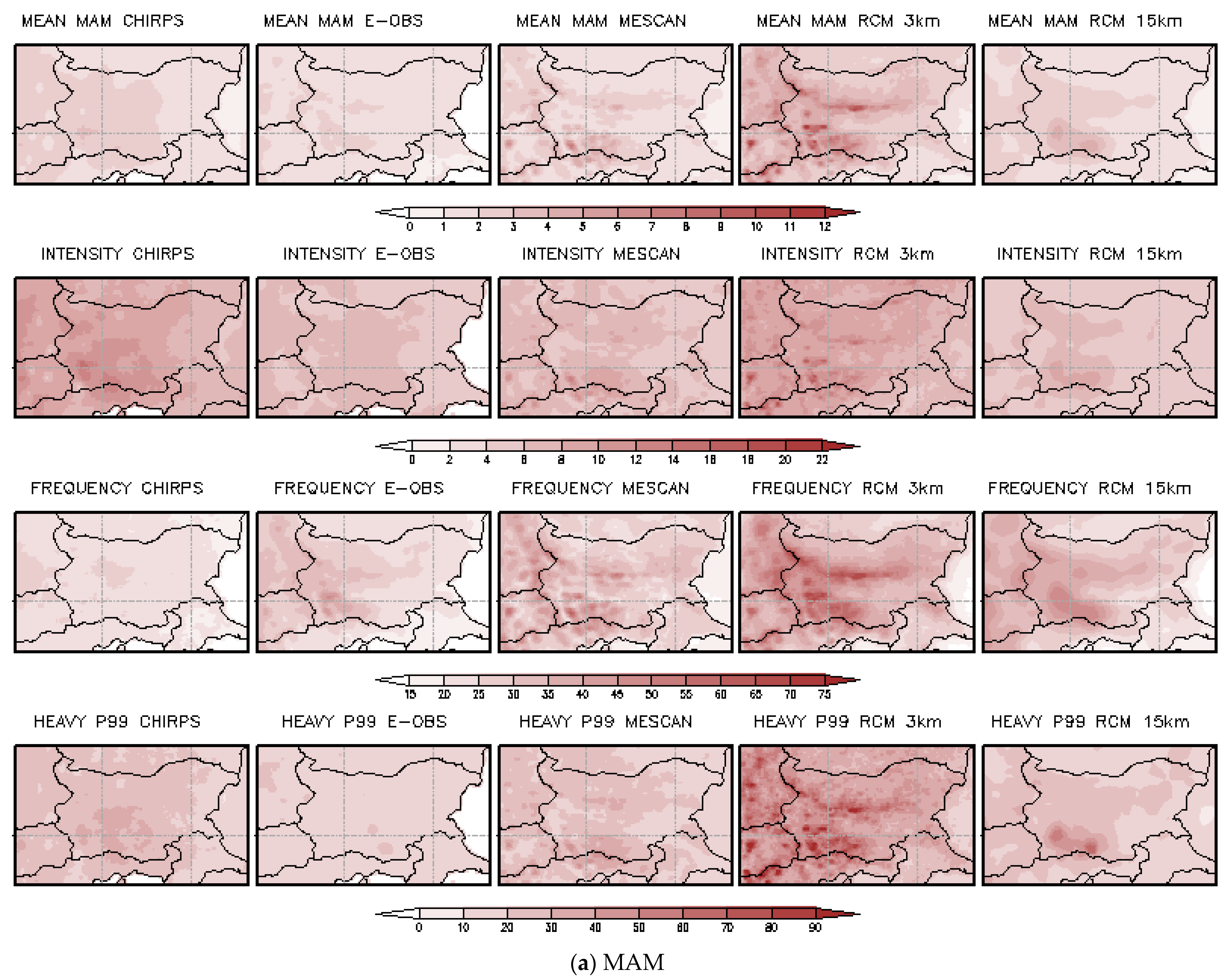
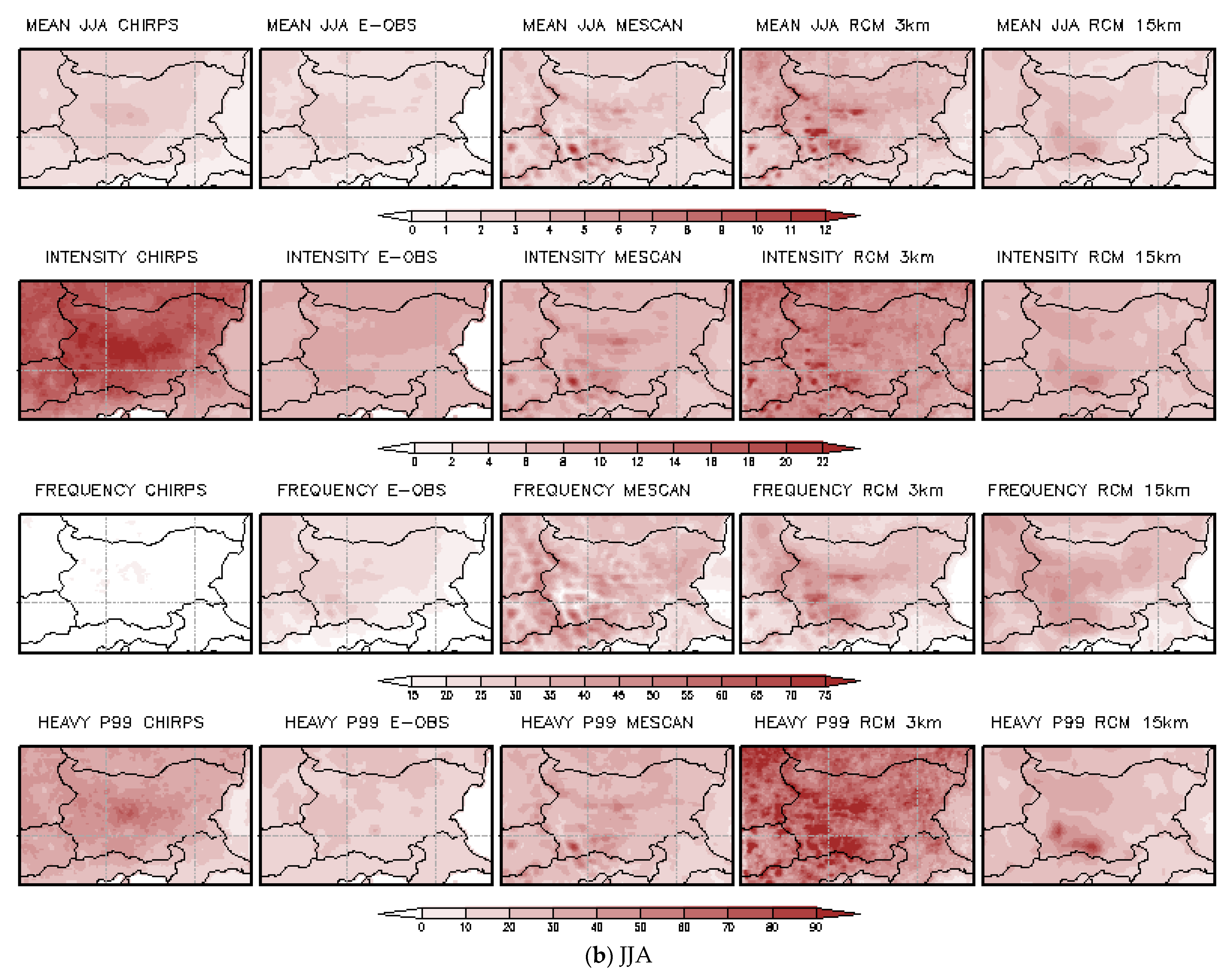
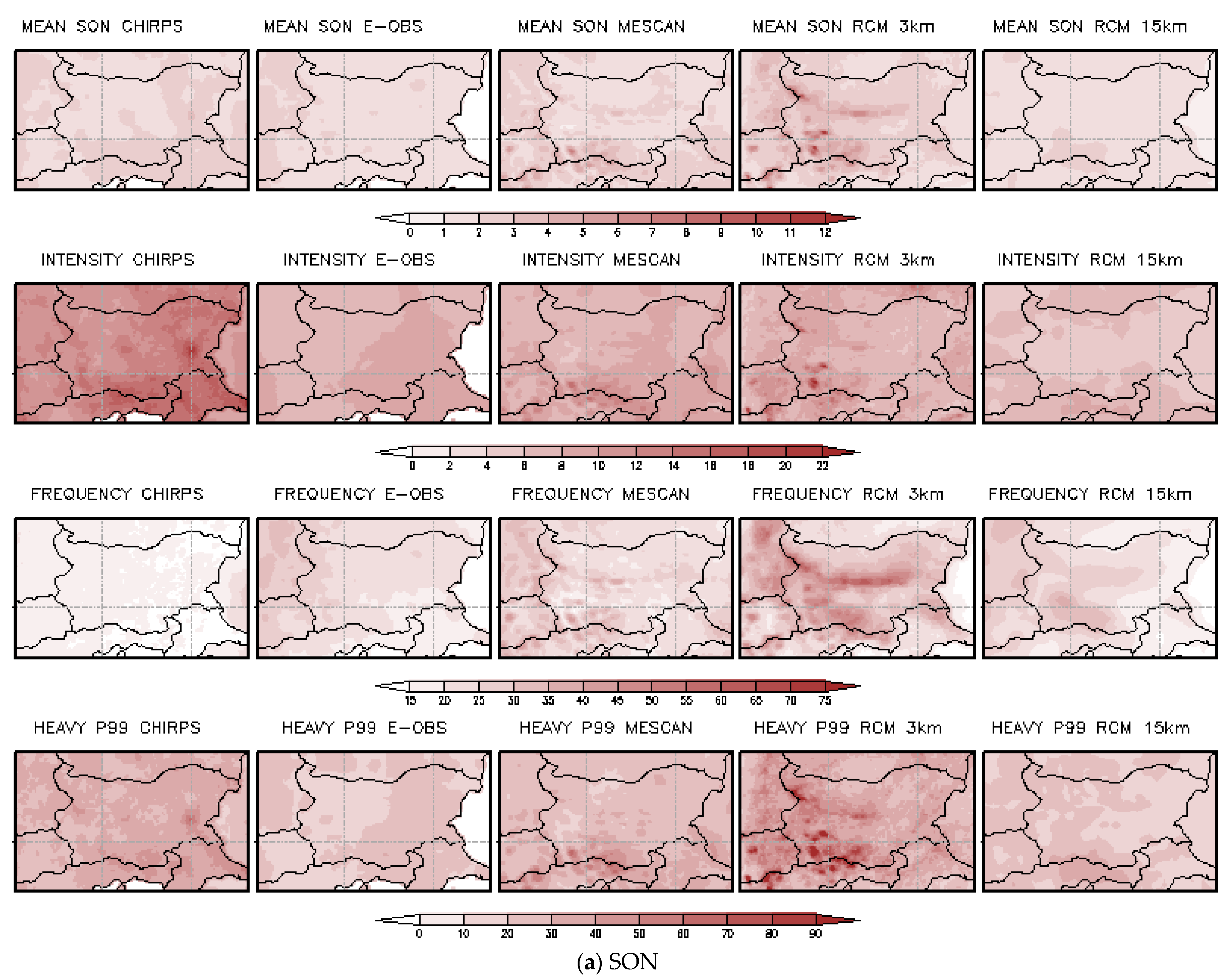
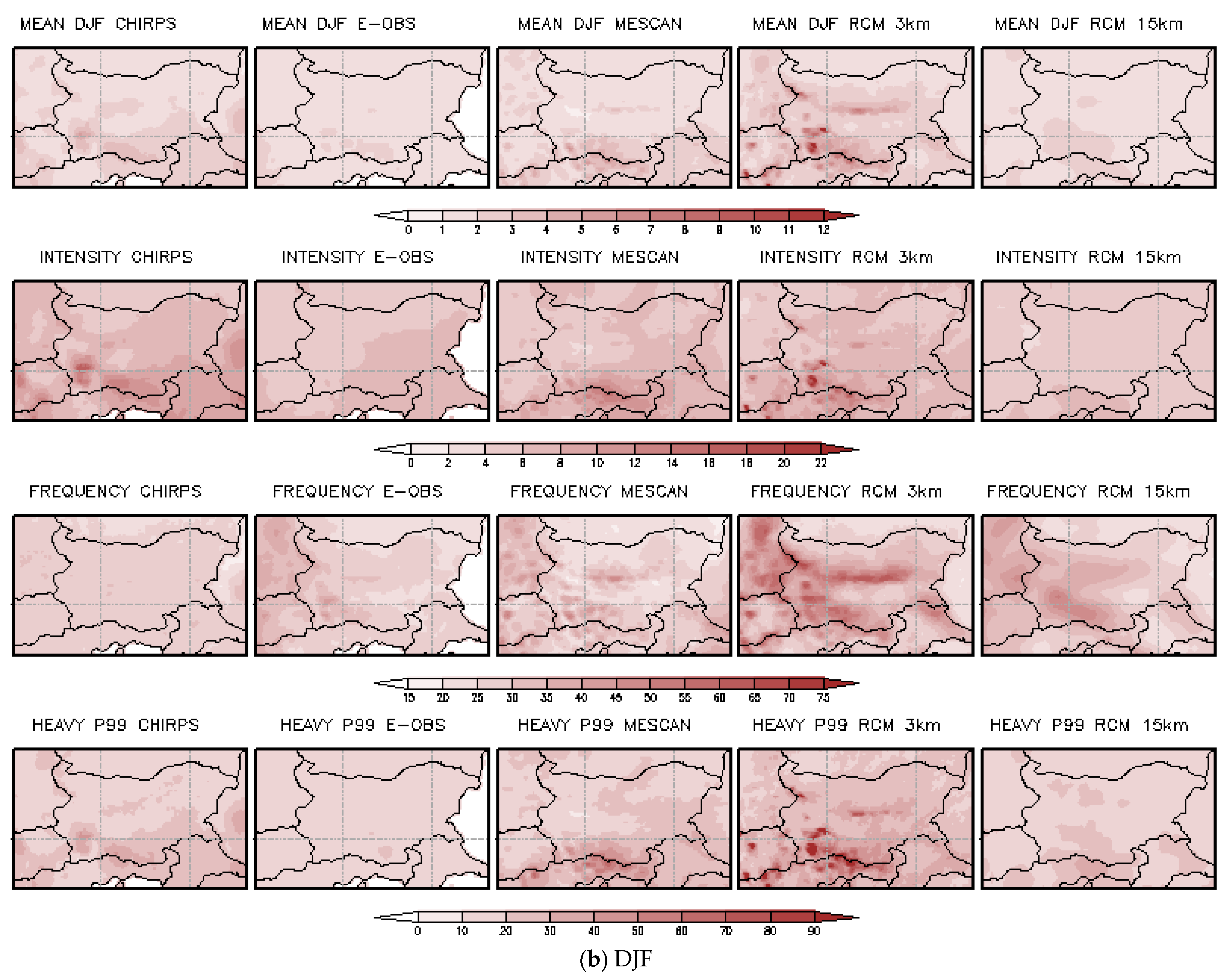


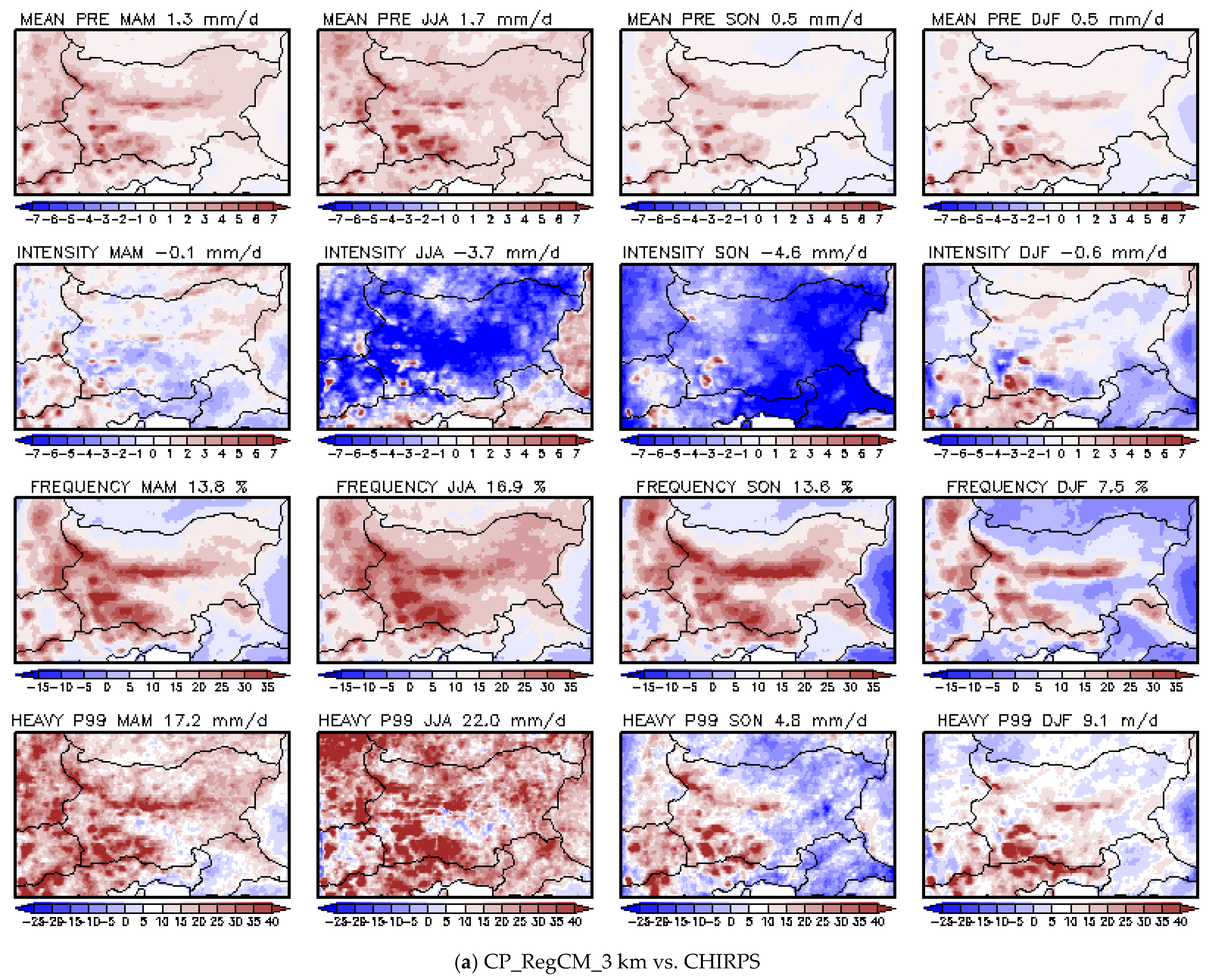
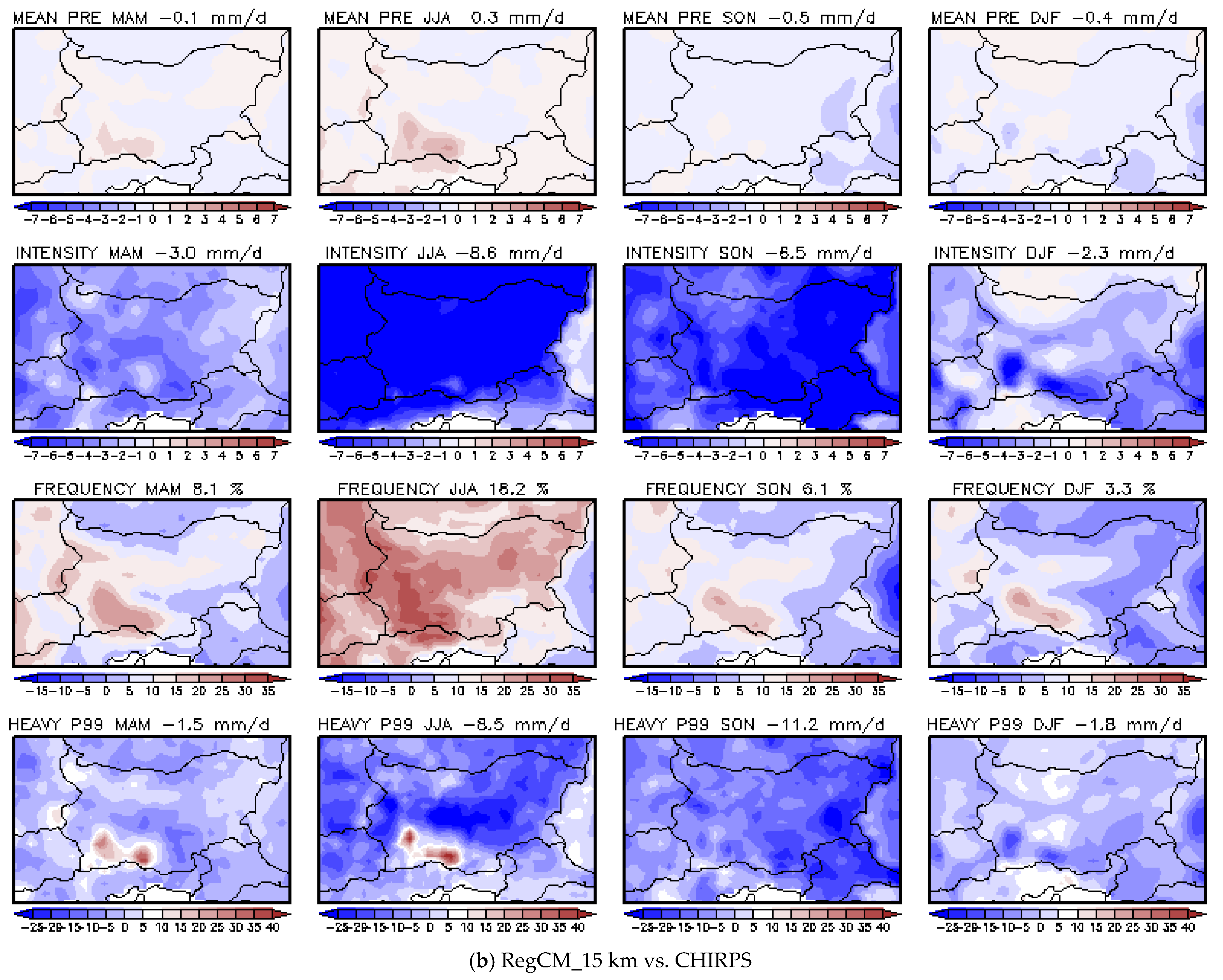


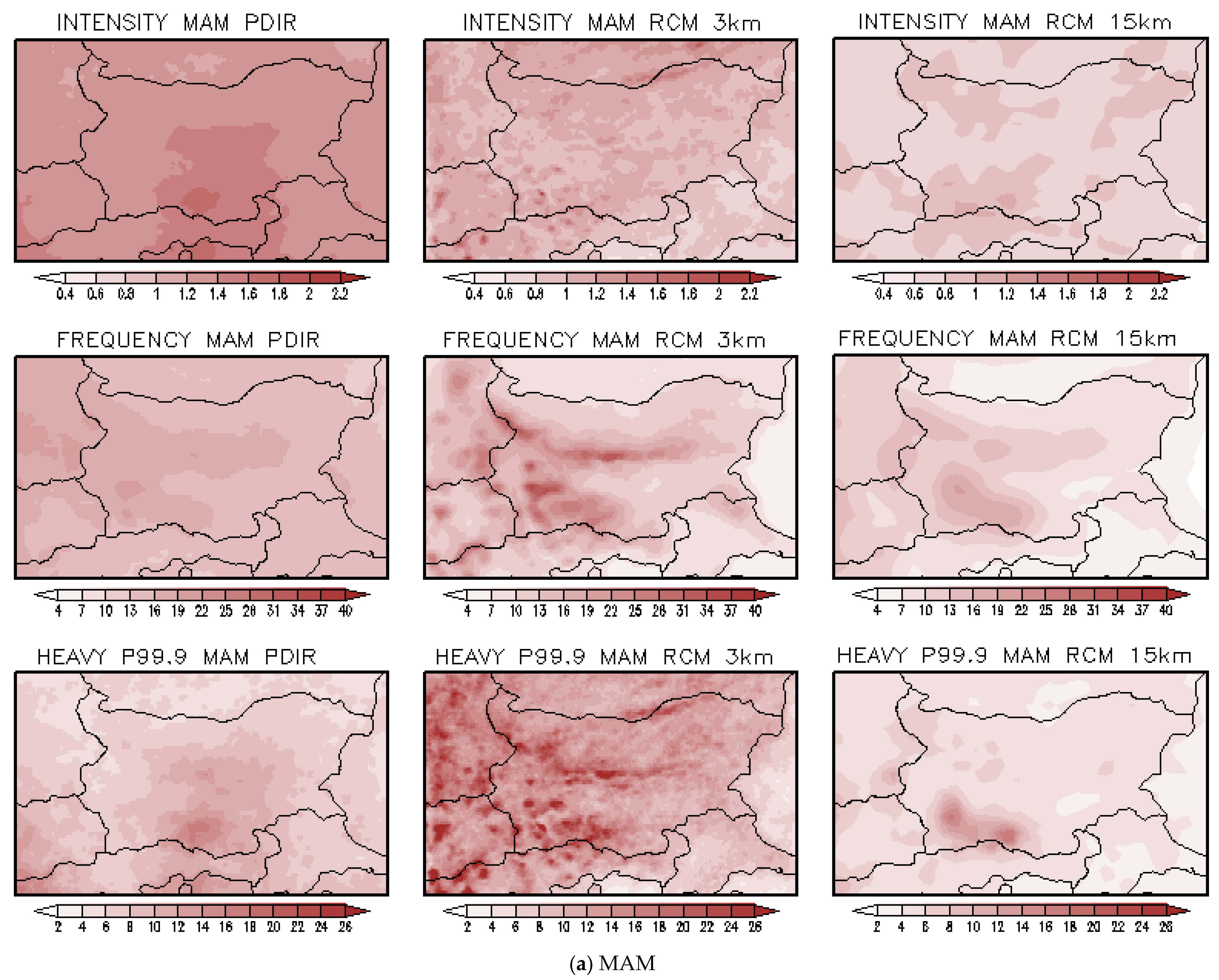
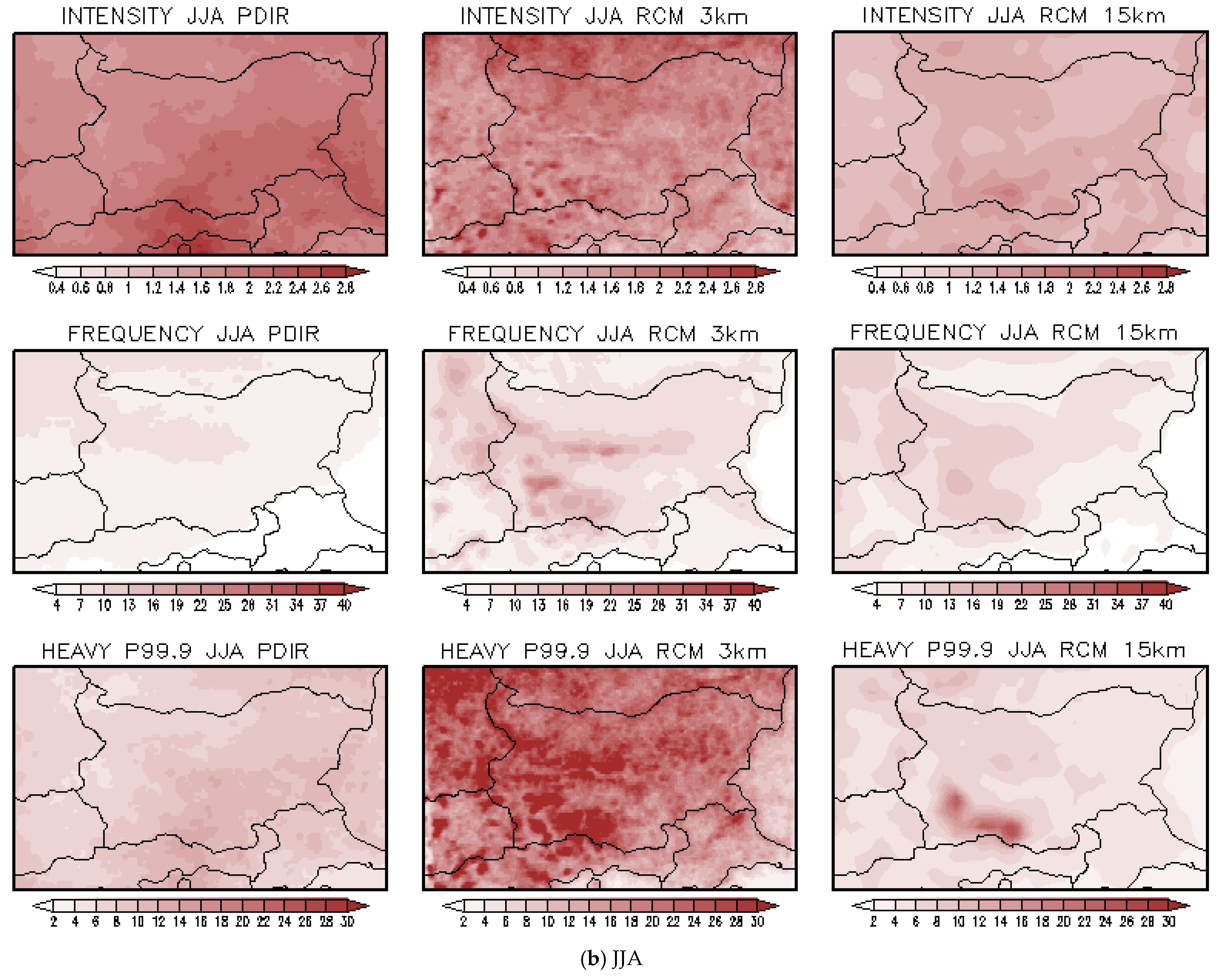
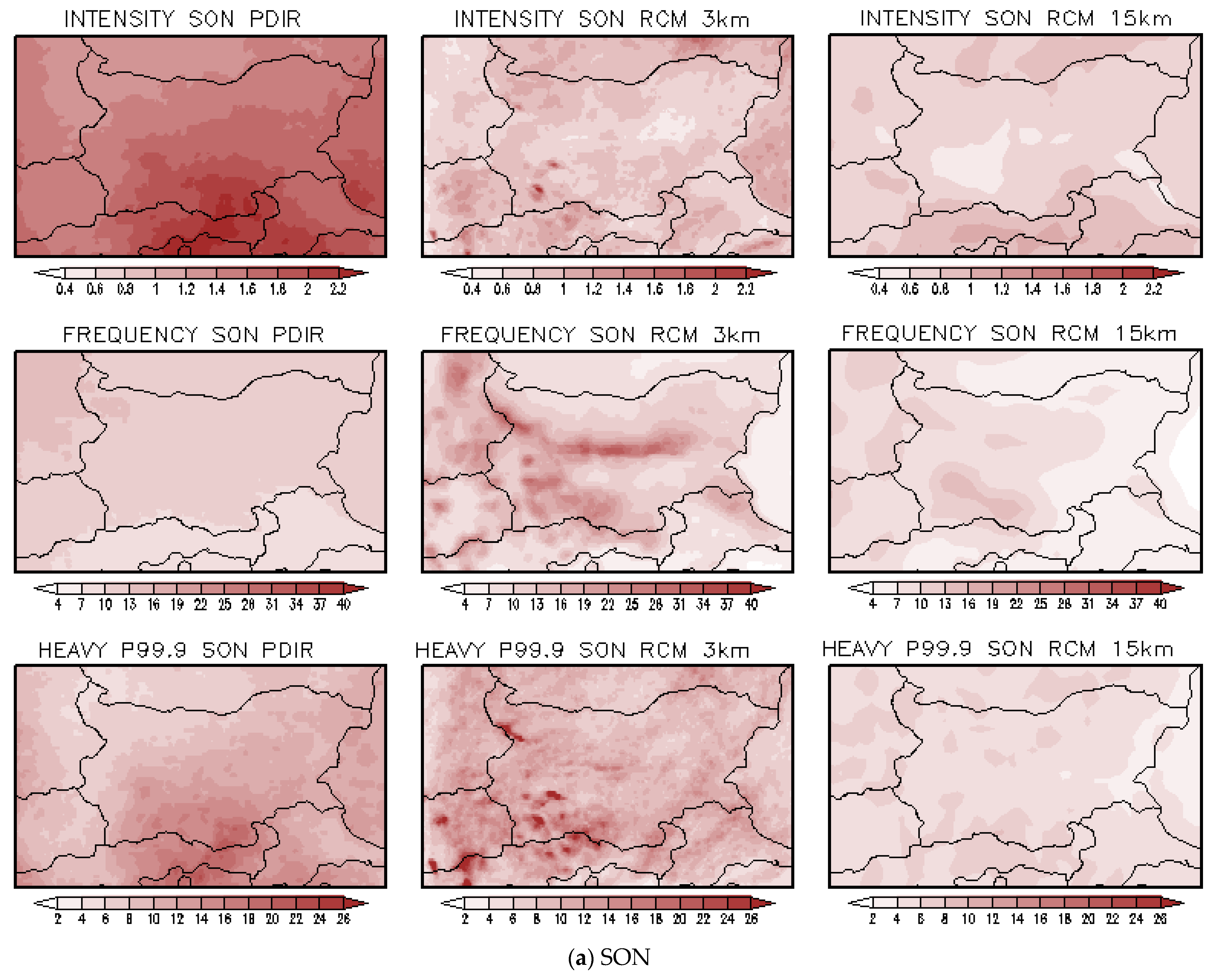
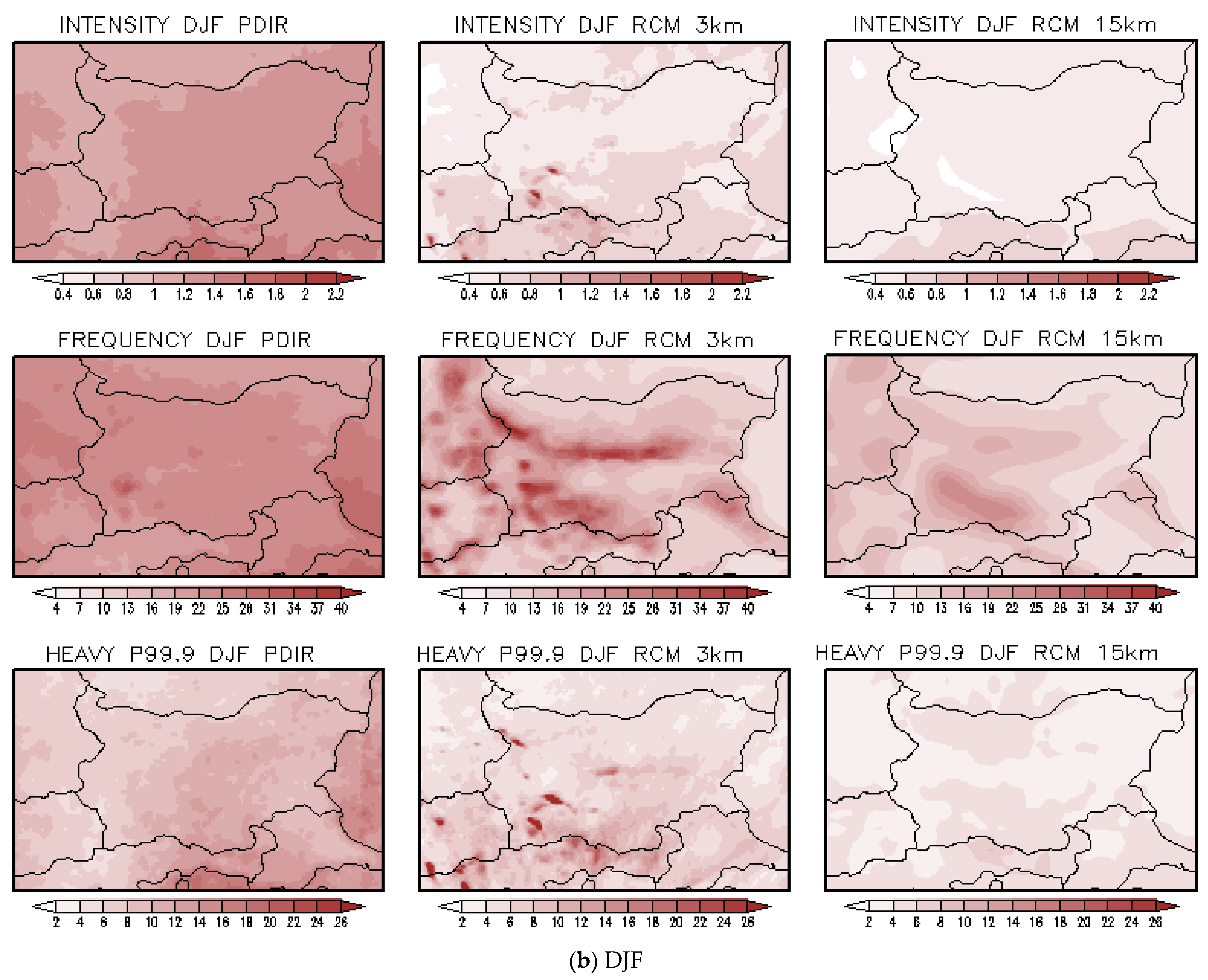
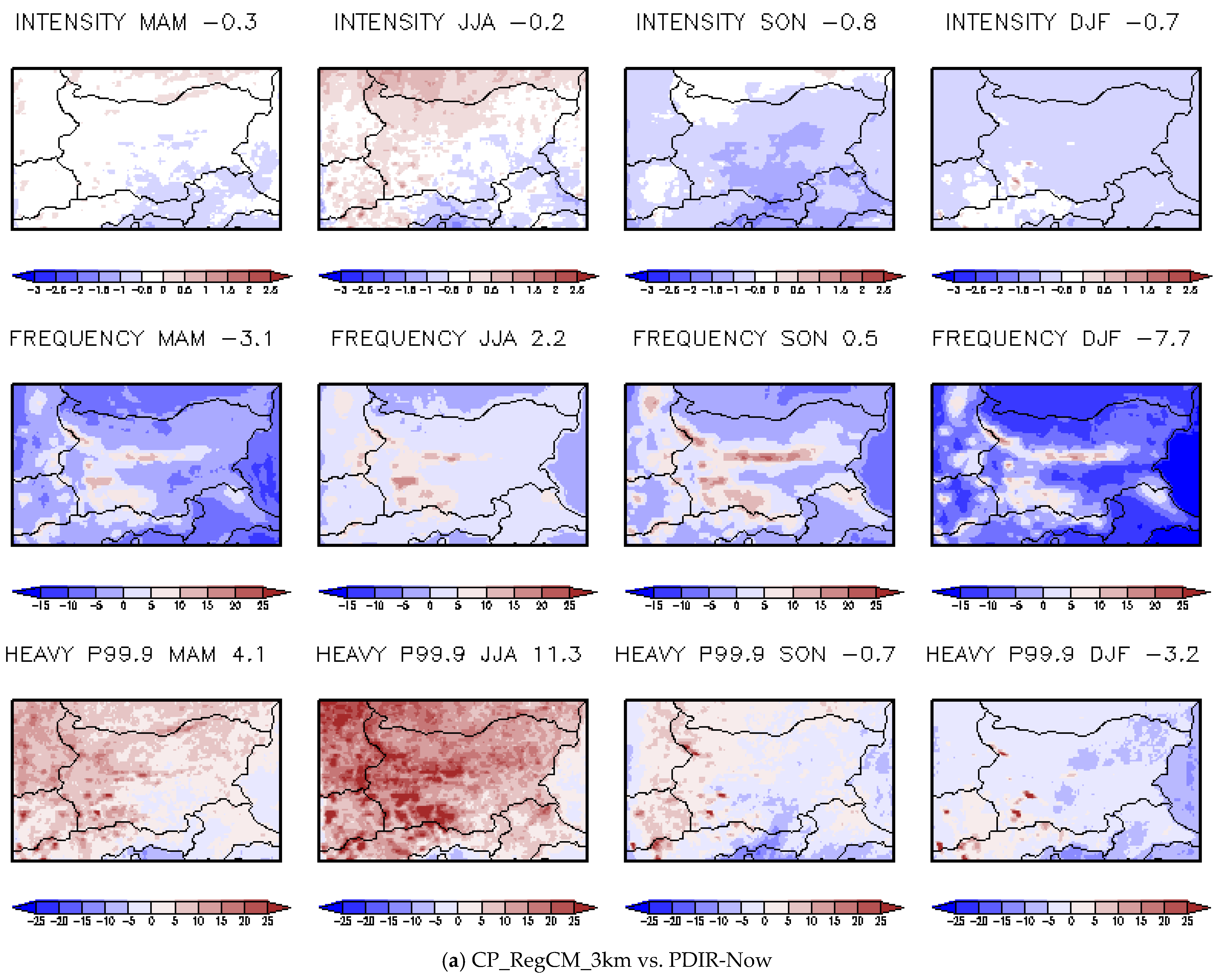
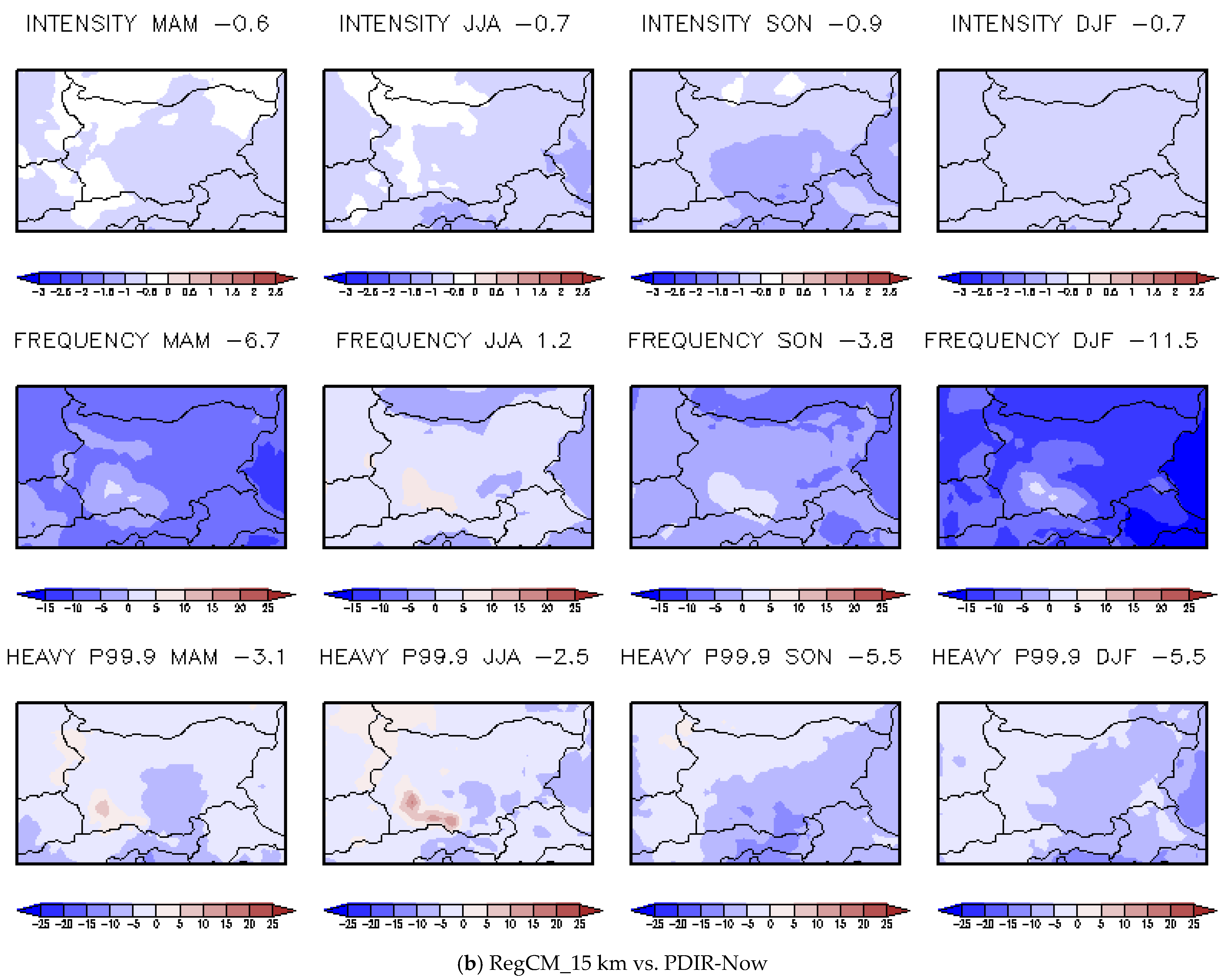
| Statistical Indices | Definition | Units |
|---|---|---|
| Mean precipitation | Daily mean precipitation. | mm/day |
| Frequency | Wet-day/hour frequency, defined as a percentage of the number of wet days/hours per season; wet day/hour is a day/hour with precipitation ≥ 1 mm/0.1 mm. | (%) |
| Intensity | Wet-day/hour intensity, defined as a day/hour with precipitation ≥1 mm/0.1 mm. | mm/day; mm/hour |
| Heavy precipitation (p99/p99.9) | P99 and P99.9 percentiles, defined as the 99th/99.9th percentile of all daily/hourly precipitation events; percentiles are calculated using all events (wet and dry) following Schär [29]. | mm/day; mm/hour |
| Mean bias | RegCM—Observation. | mm/day; mm/hour and (%) |
| Name/Availability | Spatial Resolution | Temporal Resolution | Data Source and Region | Reference |
|---|---|---|---|---|
| E-OBS v.25e (1950–2021) | 0.1° × 0.1° | daily | Station (Europe) | [30] |
| CHIRPS (1981–now) | 0.05° × 0.05° | daily | Station+Satellite (Global) | [31] |
| MESCAN-SURFEX (1961–2019) | 5.5 × 5.5 km | daily | Surface Re-Analysis (Europe) | [32,33] |
| PERSIAN-PDIR-Now (March 2000–now) | 0.04° × 0.04° | hourly | Satellite (Global) | [34] |
| DAILY | CHIRPS | MESCAN | E−OBS | RCM3 | RCM15 | RCM3− CHIRPS | RCM15− CHIRPS | RCM3− MESCAN | RCM15−MESCAN | RCM3− E−OBS | RCM15− E−OBS |
|---|---|---|---|---|---|---|---|---|---|---|---|
| MEAN PRECIPITATION mm/d | |||||||||||
| MAM | 1.9 | 1.9 | 1.5 | 3.2 | 1.8 | 1.3 | −0.1 | 1.3 | −0.1 | 1.9 | 0.4 |
| JJA | 1.8 | 2.3 | 1.6 | 3.5 | 2.1 | 1.7 | 0.3 | 1.2 | −0.2 | 2.2 | 0.7 |
| SON | 2 | 2.1 | 1.8 | 2.5 | 1.5 | 0.5 | −0.5 | 0.4 | −0.6 | 0.8 | −0.3 |
| DJF | 2 | 1.9 | 1.6 | 2.5 | 1.7 | 0.5 | −0.4 | 0.6 | −0.3 | 1.0 | 0.1 |
| INTENSITY mm/d | |||||||||||
| MAM | 8.6 | 6.3 | 6 | 8.4 | 5.6 | −0.1 | −3.0 | 2.1 | −0.7 | 2.6 | −0.3 |
| JJA | 15.4 | 7.4 | 7.8 | 11.7 | 6.9 | −3.7 | −8.6 | 4.3 | −0.5 | 4.2 | −0.9 |
| SON | 12.5 | 8.2 | 7.9 | 8 | 6.1 | −4.6 | −6.5 | −0.3 | −2.1 | 0.1 | −1.7 |
| DJF | 7.4 | 6.6 | 5.9 | 6.8 | 5.1 | −0.6 | −2.3 | 0.2 | −1.5 | 0.9 | −0.8 |
| FREQUENCY % | |||||||||||
| MAM | 21.6 | 28.3 | 25.2 | 35.1 | 29.3 | 13.8 | 8.1 | 6.8 | 1.2 | 11.9 | 5.9 |
| JJA | 11.4 | 29.4 | 20.1 | 28 | 29.1 | 16.9 | 18.2 | −1.4 | −0.1 | 9.8 | 11.6 |
| SON | 16.2 | 24.7 | 23.1 | 29.6 | 22.3 | 13.6 | 6.1 | 4.9 | −2.5 | 8.2 | 0.2 |
| DJF | 27.3 | 27.8 | 27.8 | 34.7 | 30.5 | 7.5 | 3.3 | 6.8 | 2.6 | 8.1 | 3.4 |
| HEAVY PRECIPITATION P99 mm/d | |||||||||||
| MAM | 22.1 | 21.5 | 15.0 | 39.0 | 20.4 | 17.2 | −1.5 | 17.5 | −1.0 | 26.3 | 6.5 |
| JJA | 33.6 | 26.1 | 18.2 | 55.0 | 24.7 | 22.0 | −8.5 | 28.9 | −1.3 | 40.5 | 8.1 |
| SON | 32.0 | 27.7 | 20.3 | 36.5 | 20.8 | 4.8 | −11.2 | 8.8 | −6.9 | 17.6 | 1.2 |
| DJF | 20.1 | 22.6 | 14.8 | 29.2 | 18.4 | 9.1 | −1.8 | 6.7 | −4.2 | 15.0 | 3.6 |
| HOURLY | PDIR | RCM3 | RCM15 | RCM3− PDIR | RCM15− PDIR |
|---|---|---|---|---|---|
| INTENSITY mm/h | |||||
| MAM | 1.3 | 1.0 | 0.8 | −0.3 | −0.6 |
| JJA | 1.9 | 1.7 | 1.2 | −0.2 | −0.7 |
| SON | 1.7 | 0.9 | 0.8 | −0.8 | −0.9 |
| DJF | 1.3 | 0.6 | 0.5 | −0.7 | −0.8 |
| FREQUENCY % | |||||
| MAM | 15.8 | 12.7 | 9.1 | −3.1 | −6.7 |
| JJA | 5.8 | 8.0 | 7.0 | 2.2 | 1.2 |
| SON | 11.4 | 11.9 | 7.6 | 0.5 | −3.8 |
| DJF | 23.6 | 15.9 | 12.0 | −7.7 | −11.5 |
| HEAVY PRECIPITATION P99.9 mm/h | |||||
| MAM | 8.3 | 12.4 | 5.2 | 4.1 | −3.1 |
| JJA | 8.6 | 19.9 | 6.1 | 11.3 | −2.5 |
| SON | 10.8 | 10.0 | 5.3 | −0.7 | −5.5 |
| DJF | 9.5 | 6.3 | 4.0 | −3.2 | −5.5 |
Disclaimer/Publisher’s Note: The statements, opinions and data contained in all publications are solely those of the individual author(s) and contributor(s) and not of MDPI and/or the editor(s). MDPI and/or the editor(s) disclaim responsibility for any injury to people or property resulting from any ideas, methods, instructions or products referred to in the content. |
© 2023 by the authors. Licensee MDPI, Basel, Switzerland. This article is an open access article distributed under the terms and conditions of the Creative Commons Attribution (CC BY) license (https://creativecommons.org/licenses/by/4.0/).
Share and Cite
Valcheva, R.; Popov, I.; Gerganov, N. Convection-Permitting Regional Climate Simulation over Bulgaria: Assessment of Precipitation Statistics. Atmosphere 2023, 14, 1249. https://doi.org/10.3390/atmos14081249
Valcheva R, Popov I, Gerganov N. Convection-Permitting Regional Climate Simulation over Bulgaria: Assessment of Precipitation Statistics. Atmosphere. 2023; 14(8):1249. https://doi.org/10.3390/atmos14081249
Chicago/Turabian StyleValcheva, Rilka, Ivan Popov, and Nikola Gerganov. 2023. "Convection-Permitting Regional Climate Simulation over Bulgaria: Assessment of Precipitation Statistics" Atmosphere 14, no. 8: 1249. https://doi.org/10.3390/atmos14081249
APA StyleValcheva, R., Popov, I., & Gerganov, N. (2023). Convection-Permitting Regional Climate Simulation over Bulgaria: Assessment of Precipitation Statistics. Atmosphere, 14(8), 1249. https://doi.org/10.3390/atmos14081249







